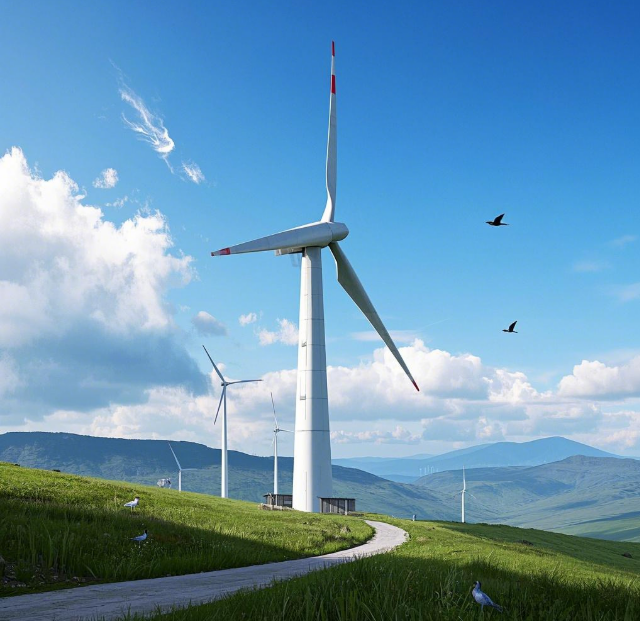With the acceleration of the digital era, the energy consumption of data centers has become increasingly prominent, and their contribution to global energy demand has been rising. In the face of this challenge, more and more data centers are beginning to explore sustainable energy solutions, among which wind turbines are gradually gaining attention as a clean and renewable energy technology.
Wind turbine application patterns in data centers
Direct installation and utilization
Some data centers choose to install wind turbines directly on or near their premises to achieve energy self-sufficiency. For example, the WindCORES project in Germany builds data centers directly inside wind turbines, using the electricity generated by the wind turbines to power the data center directly. This approach not only reduces dependence on the traditional power grid, but also significantly reduces carbon emissions. According to WindCORES, the carbon emissions of its data centers are only about 2% of those of traditional data centers.
Buy wind energy
In addition to the direct installation of wind turbines, data centers can also purchase wind energy from wind farms through power purchase agreements (PPAs). For example, AWS has invested in three wind farms in Greece and is securing energy supply for its data centers through partnerships with other renewable energy companies. Google has also entered into a power purchase agreement with an offshore wind farm in the Netherlands to provide 100% of its wind energy to its data centers in the Netherlands. This model not only supports the development of renewable energy, but also helps data centers achieve carbon neutrality goals.
Dynamic load management
To make better use of wind energy, some data centers have adopted dynamic load management techniques. By monitoring the availability of wind energy in real-time and adjusting the load of the data center based on wind speed and direction, the data center can increase the load when the wind energy is abundant and reduce the load when the wind energy is insufficient. For example, Google has developed a "carbon intelligence computing platform" that maximizes the use of wind and solar energy by optimizing the scheduling of workloads to match the availability of renewable energy.
Case study
Innovative practices at WindCORES
WindCORES is a German-based company whose data centers are built inside wind turbines and directly harness wind power to generate electricity. This innovative design not only reduces losses in the energy transmission process, but also improves energy efficiency. Data from WindCORES shows that the carbon emissions of its data centers are only about 2% of those of traditional data centers, suggesting that the direct use of wind power is an effective sustainable energy solution.

Figure: How data centers can use wind energy for sustainable energy development
Google's PPA model
Google provides 100% of its wind energy to its data centers in the Netherlands through a power purchase agreement with an offshore wind farm in the Netherlands. In addition, Google has developed a "carbon intelligence computing platform" that maximizes the use of wind and solar energy by optimizing the scheduling of workloads to match the availability of renewable energy. This model not only supports the development of renewable energy, but also helps data centers achieve carbon neutrality goals.
AWS's diversified energy strategy
AWS secures the energy supply of its data centers by investing in wind farms and partnering with other renewable energy companies. AWS has invested in three wind farms in Greece and is working with other renewable energy companies to secure energy supply for its data centers. This diversified energy strategy not only supports the development of renewable energy, but also helps data centers achieve carbon neutrality goals.
Challenges and solutions
Intermittent issues
The intermittency of wind energy is one of the main challenges faced by data centers in harnessing wind power. To combat this, data centers can employ energy storage technologies such as battery energy storage systems (BESS) and hydrogen fuel cells. These technologies can store excess energy when wind energy is abundant and provide backup energy when wind energy is low, ensuring the stable operation of data centers.
Grid integration issues
The integration of wind power into the conventional grid also presents certain challenges. To address this problem, data centers can use microgrid technology to build independent energy supply systems. Microgrid technology can not only improve the energy self-sufficiency rate of data centers, but also reduce the dependence on traditional power grids, thereby improving the stability and reliability of energy supply.
Conclusion
Leveraging wind turbines for sustainable energy in data centers not only helps reduce carbon emissions, but also improves energy efficiency and reduces costs. By directly installing wind turbines, purchasing wind energy, and optimizing load management, data centers can increase energy self-sufficiency while reducing carbon emissions. With the continuous advancement of technology and policy support, wind power will play an increasingly important role in the sustainable development of data centers.






